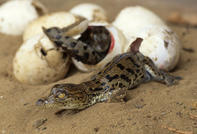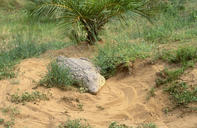Temperature Switches

Different factors come into play in the gradients or differences of temperature in reptile eggs and the resultant sex of those eggs. If more females hatched in a warmer climate and there weren't enough males, would the population's equilibrium be thrown out of whack?
Even if there were more females - meaning greater breeding stock, no one knows what might happen if the overall population shifted to, say, three females to every one male. Tent tortoise males are twenty per cent smaller than females. They have to wait until the females are ready to mate and dash from one female to another to catch any window of opportunity.
If, all of a sudden, you don't have enough males, this could throw the population into a crisis. One can only speculate how a male-dominated community would respond.
Nile Crocodiles

An ancient relative of the tortoise is seeing the effects of temperature switches. Nile crocodiles in the Greater St Lucia Wetland Park in South Africa are the southernmost population of this toothy reptile. Their breeding ground is under siege by a weed that is foreign to these parts, the notoriously invasive Caribbean creeper, the Triffid weed (Chromolaena odorata). The crocodiles at St Lucia tend to lay their eggs in open, sunny, sandy areas but in at least one breeding place, the laying site is heavily shaded by weed.
Crocodiles have a limited incubation range of between 28°C to 34°C - within that range is the ideal temperature that will produce one male to every female in the hatchlings. Amongst St Lucia's Nile crocodiles, the lower end of this 'pivotal' temperature is 31.7°C. As incubation temperatures drop to below that, the sex ratio will lean towards the production of females.
Below 27°C, healthy incubation is less likely - the baby crocs probably won't hatch.
Through two breeding seasons during a study period, soil temperatures in shaded areas reached 26.1°C and 25.6°C. Researchers also noticed that as much as 40 per cent of breeding sites were inundated with the weed in just four years of study.
They speculated that females were trying to breed in shaded areas contrary to their instinct because of a lack of suitably sunny areas. St Lucia is one of only three breeding sites for the Nile crocodile in South Africa and, if the trend is not reversed, it could become locally extinct from St Lucia.
At least the tent tortoise has the luxury of a stable and abundant population to indulge in theory and speculation. The future of its more threatened cousins, such as the geometric tortoise and the southern speckled padloper, is less certain.